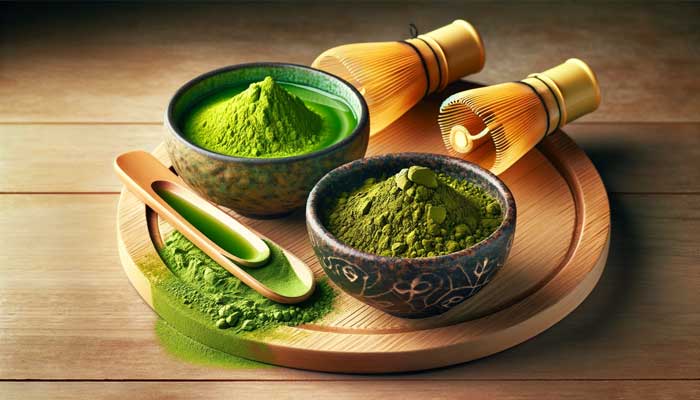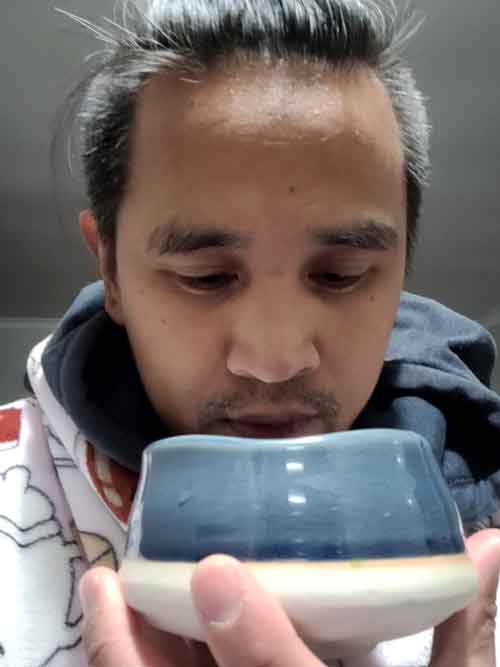When I first stumbled upon the world of matcha, it was through a small, unassuming tea shop nestled in the heart of Tokyo. The vibrant green color and the serene ritual of preparation captivated me instantly. But, upon returning home and trying to replicate that experience, I was met with disappointment. The matcha I found locally was dull, lackluster, and nothing like what I had in Japan. This experience sparked my journey into understanding the stark differences between real and fake matcha.
In this article, we’ll dive deep into the topic of “Real vs Fake Matcha,” a subject that holds significant importance for both your health and your taste buds. From traditional tea ceremonies to your morning latte, matcha is not just a beverage; it’s an experience, an art form. But not all matcha is created equal.
At UJIHA, we’re dedicated to preserving the authenticity and quality of this exquisite tea. Our ceremonial grade matcha is 100% organic, pesticide-free, sourced directly from the renowned fields of Uji, Japan, ensuring that every sip you take is as genuine as it is delightful. Join us as we explore the world of matcha, distinguishing the real from the fake, and revealing how to truly appreciate this ancient, beloved beverage.
Table of Contents
Understanding Matcha: Real vs Fake
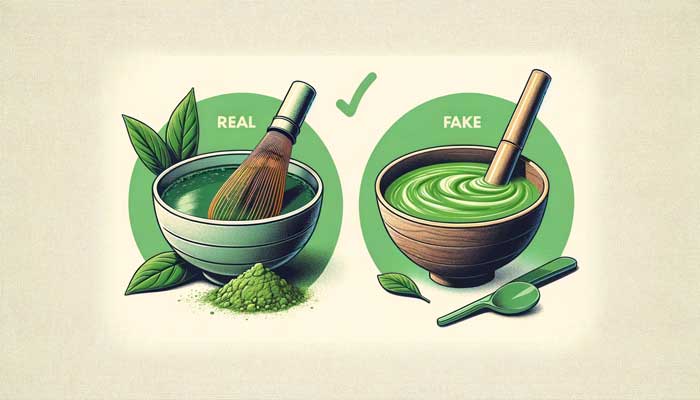
Real matcha, the heart of traditional Japanese tea ceremonies, is more than just ground green tea leaves. It’s a symbol of a centuries-old heritage, a testament to meticulous cultivation and processing methods honed over generations. Genuine matcha is made from shade-grown tea leaves, specifically the Camellia sinensis plant. These leaves are carefully cultivated under shade for about three weeks before harvest, a process that boosts chlorophyll levels and enhances the vibrant green color and amino acid content.
The traditional process of growing and processing matcha in Japan is an art in itself. After the shade-growing period, only the finest tea leaves are handpicked with great care. These leaves are then steamed to halt fermentation, dried, and slowly stone-ground into a fine, jade-colored powder. This labor-intensive process preserves the delicate flavors and nutrients, distinguishing authentic matcha from its counterparts.
In contrast, what is often marketed as ‘matcha’ outside of these traditional methods can be misleading. Fake or lower-quality matcha is often just ground green tea, lacking the shade-growing and careful processing steps. This results in a coarser texture, a more muted color, and a significantly different flavor profile. Often, these lower-grade products are mixed with fillers, sweeteners, or artificial colors to mimic the appearance and taste of real matcha, but they fall short in delivering the authentic experience and health benefits.
Understanding this distinction is crucial for anyone seeking the true matcha experience – one that is deeply rooted in Japanese culture and offers a unique blend of taste, health benefits, and tradition.
The Implications of Choosing Fake Matcha

Opting for lower-quality or fake matcha can have several unintended health implications, a concern often overlooked in the pursuit of this popular green tea. Authentic matcha is celebrated not just for its unique flavor but also for its myriad health benefits, including high antioxidant levels, metabolism-boosting properties, and the ability to enhance calm while increasing alertness. However, when you choose a fake or lower-quality matcha, you might be missing out on these benefits.
Fake matcha often contains additives and artificial components aimed at mimicking the vibrant color and taste of genuine matcha. These additives can range from sugar and milk powder to artificial colors and flavors. The presence of these additives not only alters the natural flavor profile of matcha but can also lead to increased sugar intake and exposure to artificial substances, which may have negative health effects. Moreover, these adulterated versions lack the high concentration of antioxidants, particularly catechins like EGCG, known for their cancer-fighting properties, found in pure matcha.
At UJIHA, we understand the importance of consuming matcha in its purest form. Our dedication to offering 100% organic and pesticide-free matcha is a testament to our commitment to health and authenticity. We ensure that our matcha is free from harmful chemicals and unnecessary additives, preserving the natural benefits and flavors of this traditional Japanese tea. By choosing UJIHA’s matcha, you’re not just enjoying a delicious beverage; you’re embracing a healthier, more authentic option that stays true to the centuries-old traditions of Japanese tea culture.
Identifying Authentic Matcha
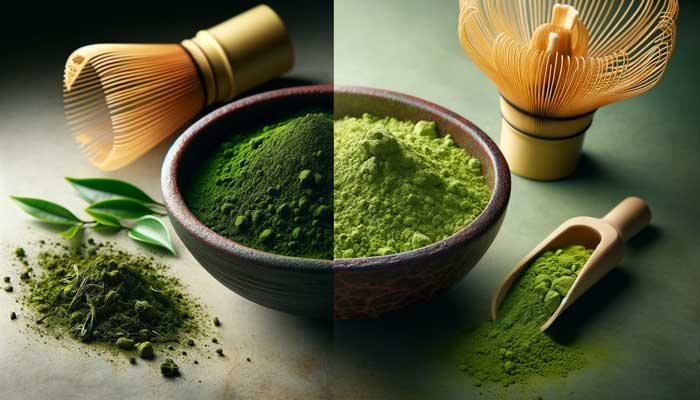
Knowing how to identify authentic matcha is key to ensuring you enjoy the full range of its benefits and the richness of its taste. The first indicator of real matcha is its color. Genuine matcha possesses a vibrant, bright green hue, a result of the high chlorophyll content from shade-growing the tea leaves. If the powder appears yellowish or dull, it’s likely of inferior quality or not true matcha.
Texture is another crucial aspect. Authentic matcha is finely ground to a smooth powder, so fine that it feels silky between your fingers. When whisked in water, it should dissolve easily and create a frothy, smooth consistency without any clumpiness. In contrast, lower-quality matcha tends to be grainy or coarse, and it doesn’t dissolve well, often leaving a gritty residue at the bottom of the cup.
The aroma of matcha is also a telltale sign of its quality. Real matcha emits a fresh, grassy smell with subtle undertones of sweetness. If the powder lacks aroma or smells stale, it is likely not fresh or of high quality.
Understanding the significance of sourcing and certification is vital in verifying the authenticity of matcha. Matcha that is sourced directly from Japan, specifically from regions known for their tea cultivation like Uji, is more likely to be authentic. Certifications like organic or JAS (Japanese Agricultural Standard) certification can also be indicators of quality, ensuring that the matcha is grown and processed according to strict guidelines.
UJIHA’s matcha serves as an exemplar of what genuine, high-quality matcha should embody. Sourced directly from Uji, Japan, our matcha is grown under the ideal conditions required for producing the highest grade of tea. Our commitment to organic farming practices ensures that our matcha is not only authentic but also free from pesticides and harmful chemicals. The bright green color, fine texture, and fresh aroma of our matcha are testaments to its quality and authenticity. By choosing UJIHA’s matcha, you’re choosing a product that truly represents the pinnacle of traditional matcha cultivation and production.
Is There Artificial Matcha?
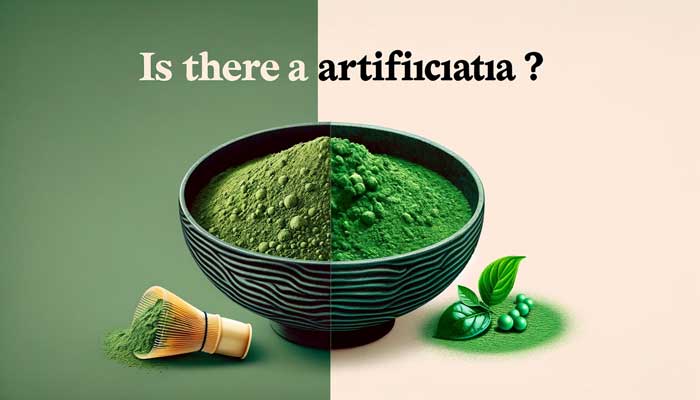
In today’s market, the term “artificial matcha” has emerged, referring to products that are marketed as matcha but do not adhere to the traditional standards and qualities of authentic matcha. This artificial matcha often bears little resemblance to the genuine product in terms of cultivation, processing, and nutritional value.
Artificial matcha is typically made from standard green tea leaves that have not been shade-grown, a crucial step in producing real matcha. Without the shade-growing process, the tea leaves lack the enhanced chlorophyll and amino acid levels that give authentic matcha its vibrant green color and rich umami flavor. The leaves used in artificial matcha are often ground using modern, mechanical methods, as opposed to the traditional stone-grinding technique. This results in a coarser powder that lacks the fine, silky texture of true matcha.
The differences between artificial and authentic matcha are stark. Artificial matcha often has a duller green color, a more astringent and bitter taste, and a grainy texture. Nutritionally, it falls short of the health benefits offered by real matcha. Authentic matcha is packed with antioxidants, particularly catechins like EGCG, and contains L-theanine, an amino acid that promotes relaxation without drowsiness. These elements are significantly reduced or absent in artificial matcha.
Furthermore, to compensate for these deficiencies, artificial matcha products may contain added colorants to enhance their green hue, and sweeteners or flavor enhancers to improve taste. These additives detract from the natural health benefits and authentic experience of traditional matcha.
In summary, artificial matcha is a far cry from the authentic product both in its production and its health benefits. Understanding these differences is key for consumers who seek the genuine matcha experience, both for its unique taste and its myriad health benefits.
What to Look Out for When Buying Matcha Powder?
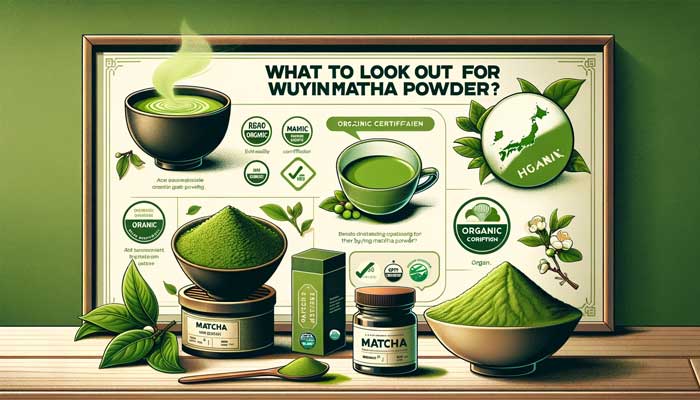
Selecting authentic matcha powder can be a nuanced task, especially with the variety of products available in the market. Here are some detailed guidelines to help you make an informed decision:
- Color: Authentic matcha should have a vibrant, bright green color. This is a result of the high levels of chlorophyll, which are preserved through the shade-growing process. A dull, yellowish, or brownish-green color often indicates either aging or lower quality.
- Texture: High-quality matcha is finely ground to a powder so smooth that it can feel almost creamy to the touch. If the powder feels coarse or gritty, it’s likely not ground finely enough, which is a sign of lower quality.
- Aroma: Genuine matcha emits a fresh, grassy aroma, with hints of sweetness. If the powder lacks aroma or smells stale or musty, it is likely not fresh or of high quality.
- Origin and Sourcing: Matcha of the highest quality typically comes from Japan, particularly from regions renowned for matcha production like Uji, Nishio, and Mie. Verify the origin and ensure that it’s sourced directly from these regions.
- Certifications: Look for certifications such as USDA Organic, JAS (Japanese Agricultural Standard), or similar organic certifications from reputable bodies. These certifications are indicators that the matcha has been grown and processed according to strict organic standards.
- Ingredients: Pure matcha should contain only one ingredient – matcha. Be wary of products with added sugars, milk powders, flavorings, or colorants. These additives are used to enhance the flavor and appearance of lower-quality matcha.
- Packaging: Matcha should be stored in airtight, opaque containers to protect it from light and air, which can degrade its quality. Transparent packaging or packaging that isn’t airtight can be a sign of a product that hasn’t been handled with care.
- Price: While price isn’t always a direct indicator of quality, extremely cheap matcha might be a red flag. Producing authentic matcha is a labor-intensive process, and its price usually reflects this.
- Brand Reputation: Research the brand. Established brands with a focus on authenticity and quality are more likely to provide high-grade matcha.
By considering these factors, you can significantly increase your chances of purchasing authentic, high-quality matcha, ensuring you get to enjoy the full range of its flavors and health benefits.
Is Starbucks Matcha Powder Real Matcha?
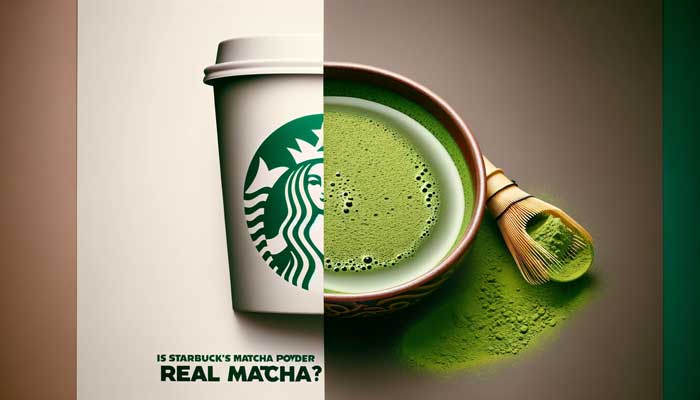
The question of whether the matcha powder used in mainstream coffee shops like Starbucks is authentic has been a topic of interest for many matcha enthusiasts. To address this, it’s important to examine both the composition and processing of the matcha powder used in such establishments.
Starbucks, known for its wide variety of coffee and tea-based drinks, offers several matcha-flavored beverages. However, the matcha powder used in these drinks differs significantly from traditional ceremonial grade matcha. Starbucks’ matcha blend, as listed in their ingredients, typically includes sugar and flavoring in addition to green tea powder. This addition of sugar and other ingredients means that it is not pure matcha in the traditional sense.
Traditional ceremonial grade matcha is made solely from shade-grown tea leaves that are carefully cultivated, harvested, and stone-ground. This process, which has been refined over centuries in Japan, yields a fine, vibrant green powder with a complex flavor profile and a host of health benefits. It contains no added sugars or flavorings. The focus is entirely on preserving the natural qualities of the tea leaf.
In contrast, the matcha powder used by Starbucks and similar mainstream coffee shops is designed more for convenience and mass appeal. The addition of sugar and flavorings makes it more palatable for a broad audience who may not be accustomed to the traditional, somewhat bitter taste of pure matcha. This also means that the nutritional profile is altered; the sugar content in such blends can overshadow the health benefits associated with traditional matcha, such as its antioxidant properties.
In summary, while Starbucks and similar outlets offer a matcha-flavored product, it’s important for consumers to recognize that this is not matcha in its pure, traditional form. These offerings cater more to a preference for sweetened, flavored beverages rather than providing the authentic matcha experience as found in traditional ceremonial grade matcha.
What Does Authentic Matcha Taste Like?
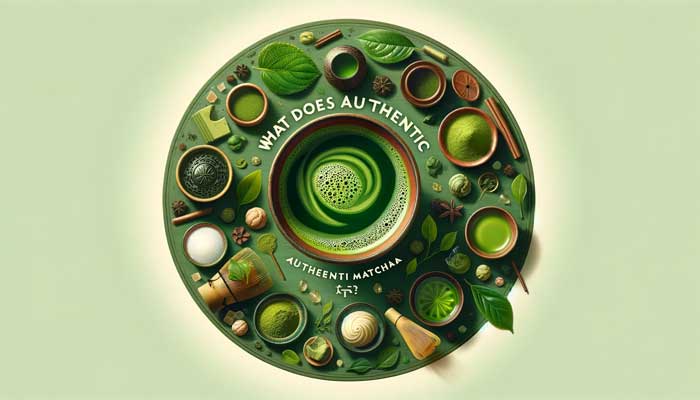
The flavor profile of authentic, high-quality matcha is a sophisticated and harmonious blend of natural tastes, a delightful experience that is distinctively different from lower-quality versions. When you sip genuine matcha, you are greeted with a rich, complex array of flavors that are deeply rooted in its traditional Japanese origins.
One of the most prominent characteristics of authentic matcha is its vibrant umami flavor. Umami, often described as a savory richness, is the result of high levels of amino acids, especially L-theanine, produced during the shade-growing process of the tea leaves. This gives matcha a full-bodied, creamy texture that smoothly coats the palate.
Alongside the umami, there is a delicate balance of sweetness and bitterness. High-quality matcha possesses a subtle, natural sweetness, a gentle counterpoint to its mild, inherent bitterness. This bitterness is not overpowering but rather adds depth and complexity to the overall flavor profile.
Another hallmark of real matcha is its fresh, vegetal taste, reminiscent of young green vegetables or freshly cut grass. This is accompanied by a slight astringency that leaves a clean and refreshing aftertaste. The overall flavor is rounded, with no single element overwhelming the others.
In comparison, lower-quality matcha often lacks this balance and depth. It may taste overly bitter, lack the characteristic umami richness, or have an artificial or stale flavor. The color, too, can be a giveaway – while high-quality matcha is a bright, vivid green, inferior versions may appear dull or yellowish, indicating a lack of freshness or improper processing.
Authentic matcha’s unique taste profile is a testament to the meticulous care and traditional methods employed in its cultivation and production. It’s a flavor that’s not just consumed but experienced, reflecting a heritage of craftsmanship and the purity of the tea itself.
The UJIHA Difference: Commitment to Authenticity and Quality
At UJIHA, our unwavering commitment to authenticity and quality sets us apart in the world of matcha. We take pride in our meticulous sourcing process, ensuring that every batch of our ceremonial grade matcha represents the pinnacle of traditional Japanese tea craftsmanship.
Direct Procurement from Uji, Japan:
UJIHA’s matcha journey begins in the lush, verdant fields of Uji, Japan – a region renowned for producing some of the world’s finest matcha. Our direct procurement approach means we work closely with local farmers who have honed their skills over generations. This not only supports the local economy but also ensures we have access to the highest quality tea leaves. The tea plants are shade-grown and carefully tended to enhance their flavor and nutritional content, a practice that has been refined over centuries.
Benefits of UJIHA’s Ceremonial Grade Matcha:
Choosing UJIHA’s ceremonial grade matcha offers a plethora of benefits. Firstly, the quality and purity of our matcha ensure a superior taste experience – rich, smooth, and brimming with the nuanced flavors characteristic of top-tier matcha. Nutritionally, our matcha is a powerhouse of antioxidants, offering health benefits ranging from improved metabolism to enhanced mental clarity. Additionally, our commitment to organic farming practices means our matcha is free from harmful pesticides and chemicals, ensuring a pure, healthful product.
Customer Experiences and Testimonials:
The difference in quality and taste of UJIHA’s matcha is not just something we proclaim – it’s echoed in the experiences of our customers. Many of our patrons have shared their delight in discovering the true depth and complexity of matcha’s flavor through our products. Others have noted the noticeable difference in the vibrancy of the color and the smoothness of texture compared to other brands. Fitness enthusiasts and health-conscious customers have praised the matcha for its beneficial impact on their wellness routines. These testimonials stand as a testament to the exceptional quality of UJIHA’s matcha and the satisfaction it brings to those who choose it.
In essence, the UJIHA difference is about more than just selling matcha; it’s about offering an authentic experience that honors the rich heritage of Japanese matcha while ensuring the highest standards of quality and taste. Our dedication to these principles is what makes UJIHA’s matcha a remarkable choice for connoisseurs and newcomers alike.
Conclusion
In exploring the contrasts between real and fake matcha, we’ve journeyed through a landscape rich in tradition, quality, and authenticity. The key distinctions are clear: true matcha, like that offered by UJIHA, is a product of careful cultivation and traditional processing, resulting in a vibrant green color, a fine silky texture, and a complex flavor profile rich in umami with balanced sweetness and bitterness. On the other hand, fake matcha often falls short, marked by inferior processing, additives, and a lackluster flavor profile.
At UJIHA, our mission transcends simply selling matcha; we strive to bring the authentic essence of Uji, Japan, to your cup. Our commitment to providing high-grade, affordable, and authentic matcha ensures that the revered traditions of Japanese matcha are honored and made accessible to all. We believe that everyone deserves to experience the genuine taste and the myriad health benefits that come with real ceremonial grade matcha.
We invite you, our readers, to embark on this flavorful journey with UJIHA. Experience the difference that authentic, high-quality matcha makes, both in your cup and in your life. Whether you’re a seasoned matcha aficionado or new to this green wonder, UJIHA offers the perfect blend of tradition, quality, and affordability. Taste the genuine matcha from UJIHA, and let it transform your tea experience into an extraordinary one.
FAQ: Real VS Fake Matcha
What’s The Difference Between Real and Fake Matcha?
Real matcha is made from shade-grown tea leaves, specifically the Camellia sinensis plant, and is stone-ground into a fine powder. It has a vibrant green color, a smooth texture, and a rich, umami flavor. Fake matcha, on the other hand, may be made from lower quality leaves, often lacks the shade-growing process, and can include additives and colorants, resulting in a dull color, coarse texture, and a less complex flavor profile.
How To Tell If Matcha Powder is Real or Fake?
Look for a bright, vibrant green color, a fine, silky texture, and a fresh, grassy aroma. Real matcha should dissolve well in water and produce a smooth, frothy consistency. Fake matcha often looks dull and has a grainy texture.
What Are The Health Implications of Consuming Fake Matcha?
Fake matcha may contain fewer antioxidants and beneficial compounds than real matcha. Additives and artificial components in fake matcha can negatively affect its nutritional value and potentially lead to health risks associated with artificial additives.
Is Starbucks Matcha Powder Real?
Starbucks matcha blend is a mix of sugar and green tea powder, lacking the pure, shade-grown, and finely ground qualities of authentic matcha. It is not considered real matcha in the traditional sense.
Why Is Authentic Matcha More Expensive?
Authentic matcha involves a labor-intensive process of shade-growing, careful selection, and traditional stone-grinding. These methods contribute to its higher price compared to mass-produced or lower-quality matcha.
Healthiness of Fake Matcha?
While fake matcha may still offer some benefits of green tea, it falls short of the full health benefits of authentic matcha, such as higher antioxidant levels and the presence of L-theanine.
Common Characteristics of Fake Matcha?
Fake matcha often has a dull, yellowish-green color, a coarse texture, and lacks the rich umami flavor of real matcha. It may also include additives and sweeteners.
What’s The Taste Difference Between Real and Fake Matcha?
Real matcha has a rich, creamy texture with a balance of umami, sweetness, and a slight bitterness. Fake matcha tends to be more astringent and less flavorful.
Where Is The Source Of Real Matcha?
Real matcha is sourced from specific regions in Japan, such as Uji, Nishio, and Mie, known for their high-quality tea cultivation.
What to Look for on Matcha Labels?
Check for origin (preferably Japan), certifications (like USDA Organic or JAS), ingredients (should be only matcha, no additives), and color and texture descriptions.
What Certifications for Authentic Matcha?
Look for certifications like USDA Organic, JAS (Japanese Agricultural Standard), or similar certifications from reputable bodies, which indicate quality and purity.
What Color Indicates Matcha Authenticity?
Authentic matcha should have a bright, vibrant green color. A dull or yellowish-green color often indicates lower quality or aged matcha.
Can I Use Fake Matcha in Recipes?
While you can use fake matcha in recipes, it won’t provide the same depth of flavor or health benefits as real matcha.
What Are The Processings of Real vs Fake Matcha?
Real matcha is shade-grown and stone-ground, a process preserving its nutrients and flavor. Fake matcha may skip these traditional methods, leading to a lower quality product.
Why Shade-Grown Matcha is Considered Real?
Shade-growing increases chlorophyll and L-theanine levels in the tea leaves, contributing to the vibrant color and unique flavor profile of real matcha.
What Are The Environmental Impact of Producing Real vs Fake Matcha?
Real matcha, especially when organically produced, has a lower environmental impact compared to fake matcha, which may involve chemical additives and less sustainable farming practices.
Where To Find Real Ceremonial Grade Matcha in Stores?
Authentic ceremonial grade matcha can be found in specialty stores, tea shops, and online from reputable suppliers. It’s less likely to be found in regular grocery stores.
What Is The Effect of Additives in Matcha on Authenticity?
Additives and flavorings in matcha alter its natural composition, taste, and nutritional value, detracting from the authenticity of the matcha experience.
Is It Worth Paying More for Real Matcha?
Yes, considering the superior flavor, health benefits, and traditional cultivation and processing methods, it’s worth paying more for real matcha.

